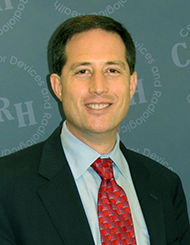By: Jeffrey Shuren, M.D., J.D.
Over the past couple of years, there has been a lot of discussion about balancing innovation and safety—whether we need to have more regulation of medical devices to assure safety and effectiveness—or whether we need less regulation of medical devices to foster innovation.
FDA’s Innovation Pathway is an exciting example of how innovation and safety and effectiveness don’t have to exist on opposite ends of a swinging pendulum. They can be complementary, mutually supporting aspects of our public health mission.
 The goal of the Innovation Pathway is to reduce the overall time and cost it takes for the development, assessment, and review of safe and effective medical devices that address unmet medical needs, so these devices can get to the patients who need them sooner without jeopardizing patient safety.
The goal of the Innovation Pathway is to reduce the overall time and cost it takes for the development, assessment, and review of safe and effective medical devices that address unmet medical needs, so these devices can get to the patients who need them sooner without jeopardizing patient safety.
Another goal is to improve how FDA and innovators work together. We can achieve that with our new Innovation Pathway through earlier engagement and more collaboration.
We’re also experimenting with new ideas—creating sort of a living laboratory or incubator. Through the Innovation Pathway, we are developing and rapidly testing new approaches to pre-market review including the use of a decision support tool that will help assure that the regulatory decisions we make about whether or not to approve early clinical studies are more transparent and consistent. Such a tool can help us decide, for example, whether there is sufficient evidence to allow the device to be studied for the first time in humans.
Additionally, we’re implementing a new suite of information technology tools that will improve FDA’s communication with sponsors.
Like any strong and successful business, when we find an approach that works—in this case, when tested in the Innovation Pathway—we will roll it into our existing processes for other devices where it adds value, thereby leading to improvements in all of our pre-market programs. When an approach doesn’t work, we will throw it out and move on.
And, one of the unique ways we’ve developed the Innovation Pathway is through the Entrepreneurs in Residence (EIR) program, which is supported by the White House Office of Science and Technology as a component of the Administration’s Strategy for American Innovation. The EIR program brought together experts outside FDA to work with agency staff and leadership to develop the Innovation Pathway 2.0.
Today we are very excited to announce that three innovators with products for patients with end stage renal disease – ESRD – have been chosen to participate in our Innovation Pathway 2.0. We received 32 applications in response to our January call for innovative treatment technologies for ESRD. Later this year, we may accept additional applicants from the ESRD challenge onto the Innovation Pathway.
We chose to focus on ESRD because of its public health impact—more than half a million Americans suffer from ESRD—and because management of ESRD is largely dependent upon medical device technology, such as hemodialysis equipment. Most dialysis patients spend long hours in specialized outpatient clinics, lowering quality of life and reducing their productivity. In addition, Medicare covers some 75 percent of ESRD health care costs, which in 2009, topped $29 billion.
We think the Innovation Pathway can help medical technology reach patients with unmet medical needs such as those suffering from ESRD. But, equally as important, we want to apply what we learned from our Innovation Pathway experience throughout our device review processes.
It’s vital to understand the Innovation Pathway does not lower our standards for medical devices. The U.S. standards of reasonable assurance of safety and effectiveness and of relying on valid scientific evidence have served patients and industry well. The Innovation Pathway 2.0 illustrates that there are ways to facilitate innovation without compromising our standards and patient safety.
Jeff Shuren is the Director of FDA’s Center for Devices and Radiological Health
